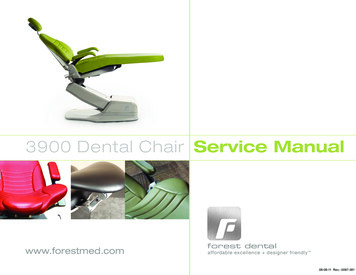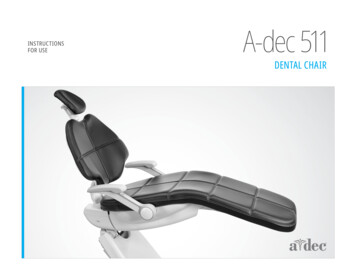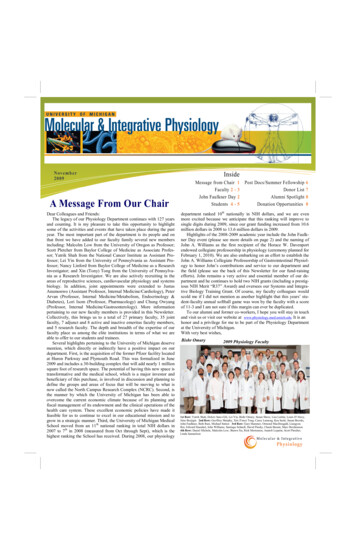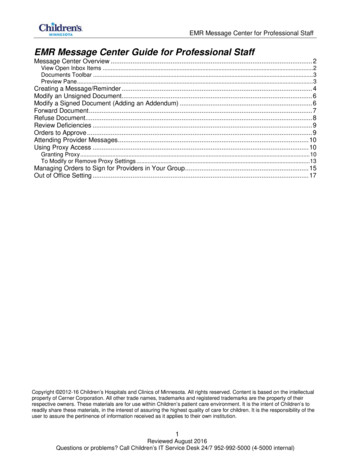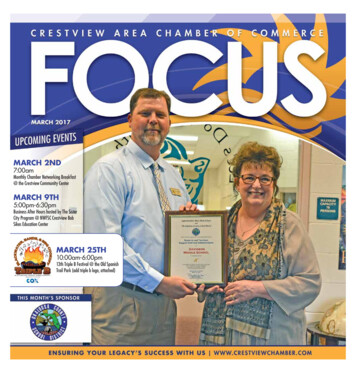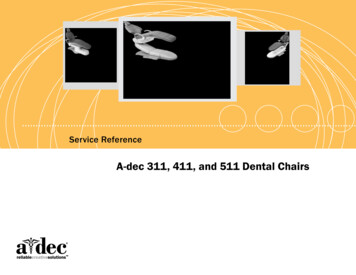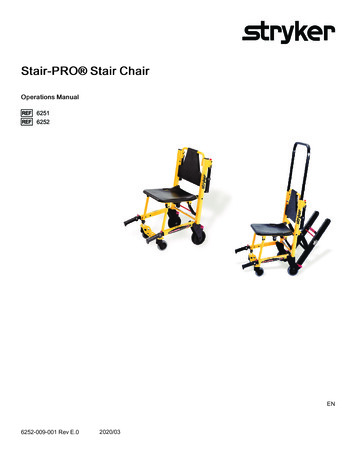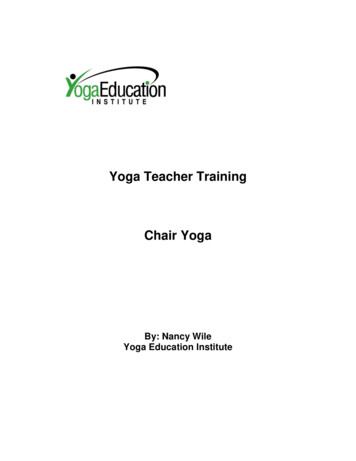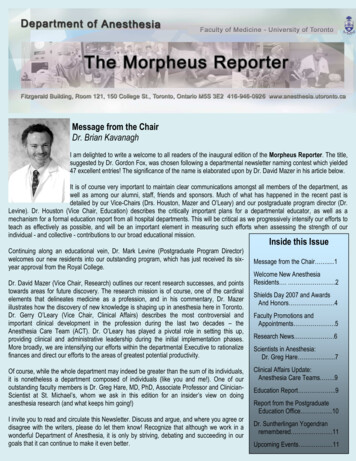
Transcription
Message from the ChairDr. Brian KavanaghI am delighted to write a welcome to all readers of the inaugural edition of the Morpheus Reporter. The title,suggested by Dr. Gordon Fox, was chosen following a departmental newsletter naming contest which yielded47 excellent entries! The significance of the name is elaborated upon by Dr. David Mazer in his article below.It is of course very important to maintain clear communications amongst all members of the department, aswell as among our alumni, staff, friends and sponsors. Much of what has happened in the recent past isdetailed by our Vice-Chairs (Drs. Houston, Mazer and O’Leary) and our postgraduate program director (Dr.Levine). Dr. Houston (Vice Chair, Education) describes the critically important plans for a departmental educator, as well as amechanism for a formal education report from all hospital departments. This will be critical as we progressively intensify our efforts toteach as effectively as possible, and will be an important element in measuring such efforts when assessing the strength of ourindividual - and collective - contributions to our broad educational mission.Inside this IssueContinuing along an educational vein, Dr. Mark Levine (Postgraduate Program Director)welcomes our new residents into our outstanding program, which has just received its sixyear approval from the Royal College.Dr. David Mazer (Vice Chair, Research) outlines our recent research successes, and pointstowards areas for future discovery. The research mission is of course, one of the cardinalelements that delineates medicine as a profession, and in his commentary, Dr. Mazerillustrates how the discovery of new knowledge is shaping up in anesthesia here in Toronto.Dr. Gerry O’Leary (Vice Chair, Clinical Affairs) describes the most controversial andimportant clinical development in the profession during the last two decades – theAnesthesia Care Team (ACT). Dr. O’Leary has played a pivotal role in setting this up,providing clinical and administrative leadership during the initial implementation phases.More broadly, we are intensifying our efforts within the departmental Executive to rationalizefinances and direct our efforts to the areas of greatest potential productivity.Of course, while the whole department may indeed be greater than the sum of its individuals,it is nonetheless a department composed of individuals (like you and me!). One of ouroutstanding faculty members is Dr. Greg Hare, MD, PhD, Associate Professor and ClinicianScientist at St. Michael’s, whom we ask in this edition for an insider’s view on doinganesthesia research (and what keeps him going!)I invite you to read and circulate this Newsletter. Discuss and argue, and where you agree ordisagree with the writers, please do let them know! Recognize that although we work in awonderful Department of Anesthesia, it is only by striving, debating and succeeding in ourgoals that it can continue to make it even better.Message from the Chair .1Welcome New AnesthesiaResidents . .2Shields Day 2007 and AwardsAnd Honors 4Faculty Promotions andAppointments .5Research News 6Scientists in Anesthesia:Dr. Greg Hare .7Clinical Affairs Update:Anesthesia Care Teams .9Education Report .9Report from the PostgraduateEducation Office .10Dr. Suntherlingan Yogendranremembered .11Upcoming Events 11
Welcome New Anesthesia Residents!Dr. Mark Levine, Director, Postgraduate EducationOn July 1, 2007 we will be joined by a new group of PG 1 residents. This is a larger cohort than we havehad in recent years and will hopefully help, in a small way, to deal with the human resource issues we facein anesthesia in Canada. We have twenty new PG1 residents: thirteen women and seven men. Fifteen aregraduates of Canadian Medical Schools, four are International Medical Graduates (IMG’s) who were trainedabroad and plan to practice in Ontario, and one is a visa trainee who will return to his home country oncompletion of the residency.In addition to these residents we also welcome one IMG into the PG 2 year and two re-entry candidates,both previously trained as GP anesthetists, into the PG 3 year. I would like to welcome all our new traineeswho will, I am sure, enrich the department and make a significant contribution to our profession in future. The following are the PG 1residents starting on July 1st:Husni AlakkadAsim AlamIryna AleksandrovaHyong CongShefali DaveGenevieve DupuisAmy Fan-LunTara Lynn GrahamRico LeungUT Department of Anesthesia -- The Morpheus Reporter, Issue 1, July 2007 / 2
Warren LuksunSheldon LynKatherine MarseuPaula MeylerCarmen MuellerOana PredescuIan RandallMerita SimitciuNeilesh SonejiCareer Opportunities inAnesthesiologyJurgita TreigieneCatherine WongSeveral positions in AcademicAnesthesiology are currentlyavailable at our local hospitals. Visitour job postings splay current jobs.cfmUT Department of Anesthesia -- The Morpheus Reporter, Issue 1, July 2007 / 3
Awards and Honors 2007It is our great pleasure to announce the recipients of the following awards in 2007. These awards were presented at the recent 28thAnnual Shields Research Day event. Congratulations to our awardees!Award NameRecipient in 2007Dr. John Desmond AwardRobert ChenDr. Gerald Edelist AwardViren NaikDavid Fear AwardThe UT Anesthesia FacultyAwardThe Alan Laws TravelFellowshipSharon DaviesJoel KatzAngelina Guzzo andPaul McHardyIn recognition of .Excellence as a clinical teacher of undergraduatestudents in anesthesiaExcellence as a clinical teacher of residents inanesthesiaOutstanding contributions to continuing medicaleducation and continuing professional development inAnesthesiaOutstanding contributions to research in anesthesiaIn support of academic and research interests inanesthesia.R.J. Byrick AwardMichelle WhiteA.C. Bryan AwardAlbert TsuiBest research project presented by a graduate studentat the 2007 Shields Research DayDr. Hynek Rothbart AwardDov WeissBest paper presented by a resident at the 2007 ShieldsResearch DayThomas Donald HammellMemorial Award inAnesthesiaTimothy WelkeOutstanding contributions to the Residency Program(as chosen by the other residents)Ian RandallExcellence in anesthesia at the undergraduate levelDr. Evelyn Bateman AwardBest Fellows’ research paper presented at the 2007Shields Research DayUT Anesthesia Seminar RoomThe UT Anesthesia Department has a newly renovatedseminar/boardroom available to book your meetings. 8-10persons can be accommodated and an LCD projector isavailable. Please contact Danny Cavanagh at (416) 946-0926or danny.cavanagh@utoronto.ca to arrange your booking.UT Department of Anesthesia -- The Morpheus Reporter, Issue 1, July 2007 / 4
Faculty Promotions and AppointmentsWe are very pleased to congratulate the following faculty ontheir promotions, effective July 1, 2007:University. Please join us in wishing Professor McKnight wellin this important new position.It is also our great pleasure to welcome the following newfaculty members, effective July 1, 2007:To Professor:Dr. Andrew BakerSt. Michael’s HospitalTo Associate Professor:Dr. Stephen BrownHospital for Sick ChildrenDr. Mark CrawfordHospital for Sick ChildrenDr. Gregory HareSt. Michael’s HospitalDr. Keyvan KarkoutiUniversity Health NetworkDr. Colin McCartneySunnybrook Health SciencesCentreDr. Isabella Devito has been appointed Director,Undergraduate Education, Department of Anesthesia,University of Toronto effective July 1st, for a three-year term.Isabella may be contacted via Danny Cavanagh at (416) 9460926. We thank Isabella for taking on this important portfolio,and wish her well in this position.Dr. David McKnight has been appointed as the newAssociate Dean of Equity and Professionalism in the Faculty ofMedicine, University of Toronto. He is an Associate Professorin the Department of Anesthesia and is a Staff Anesthetist atSt. Michael’s Hospital. Professor McKnight completed both MDand postgraduate education at the University of Toronto andserved as the postgraduate education director in theDepartment of Anesthesia for 15 years. He has held manyleadership positions in the Royal College of Physicians andSurgeons of Canada including Chair of the AccreditationCommittee and Chair of the Ethics and Equity Committee.Professor McKnight has served on the Accreditation Councilfor Graduate Medical Education in the United States. He alsochairs the Ethics Committee of the CanadianAnesthesiologists’ Society. In 2006, he obtained his MHSc inBioethics at the University of Toronto and currently chairs theEducation Committee of Faculty Council. As the AssociateDean of Equity and Professionalism, Professor McKnight willadvance policy and practices within our Faculty workingclosely with the decanal team and leadership within theDr. Alayne Kealey, Lecturer, Sunnybrook HealthSciences CentreDr. Ryan Mai, Lecturer, St. Michael’s HospitalDr. Andrea Rigamonti, Assistant Professor, St.Michael’s HospitalAnd, effective August 1, 2007:Dr. Naveed Siddiqui, Assistant Professor,University Health Network (Mount Sinai)Dr. Coimbatore Srinivas, Assistant Professor,University Health Network (Toronto General)Annual Shields Research Day 2007The UT Anesthesia 28th Annual Shields Research Day eventwas held at the Metro Toronto Convention Centre on May 3rd.Over 230 clinicians and trainees from the University ofToronto, our affiliated teaching hospitals, and communityhospitals attended this very successful event to share ideas,display posters (43) and present research. This year, theAnnual Shields lectureship was given by Dr. Daniel Sesslerfrom the Outcomes Research Institute at the University ofLouisville on “Outcomes research: Moving from physiology tolarge-scale outcomes”. Dr. Sessler’s talk was followed by avery stimulating and thought-provoking open forum onanesthesia practice in Toronto, featuring Mr. Hugh MacLeod,Assistant Deputy Minister, Ministry of Health and Long-TermCare and Dr. Stephen Brown from the OMA (Section onAnesthesia). Finally, were very pleased to be joined by Mrs.Frances Lang and her family. Mrs. Lang provided us withsome very heartfelt (and entertaining) comments on her father,the late Dr. Harry Shields, the first Chair of the UT Departmentof Anesthesia.Many thanks to our faculty, trainees, staff, friends and industrysponsors (Abbott, Baxter and Draeger) for their contributionsto, and participation in this event. Special thanks to Dr. GuyPetroz, Ms. Shue Lin Loo, and the members of the organizingcommittee (Danny Cavanagh, Wendy Kubasik and JenniferMorris).We look forward to welcoming everyone back next year!UT Department of Anesthesia -- The Morpheus Reporter, Issue 1, July 2007 / 5
Research NewsDr. David Mazer, ViceChair, ResearchIt is noteworthy that the inauguralpublication of this newsletter called theMorpheus Reporter coincides with thefirst ever publication of an article inScientific American by a member of ourdepartment. Morpheus was the god ofdreams in Greek mythology, and the son of Hypnos, the god ofSleep. Dr. Bev Orser’s article entitled "Lifting the Fog aroundAnesthesia" is one of the cover stories in the June issue ofScientific American, and it eloquently outlines the currentstate of knowledge about how our anesthetic drugs actuallywork, and the quest to make them better.Morpheus is also the name of a file sharing and searchingpeer to peer client for Microsoft Windows, and through thisnewsletter, we plan to share research news in the UofTDepartment of Anesthesia. In addition to profiling a member ofour research community, the newsletter will recognize recentresearch accomplishments of our peers, some of which arelisted below.Duminda Wijeysundera and colleagues from TGH recentlypublished an article in JAMA on renal failure in cardiacsurgery, and his grant was the highest ranked in his categoryin the last Heart and Stroke Grant competition.Congratulations also to the following individuals who haverecently been awarded CAS Research Awards:Dr. Frances Chung, TWH, received the 2007 CASResearch Recognition Award, the greatest recognition forresearch bestowed upon an individual by the CAS, for hersustained and outstanding contributions to Outpatient andAmbulatory Anesthesia.Dr. Keyvan Karkouti, Toronto General, winner of theBristol-Myers Squibb-CAS Career Scientist Award inAnesthesia and Peri-operative Medicine valued at 270,000 over three years for his research Improvinghemostasis management in cardiac surgery.Dr. Zeev Friedman, Mount Sinai Hospital, recipient of theCanadian Anesthesiologists’ Society Research Award witha value of 20,000 for his project titled: Clinical Impact ofCricothyrotomy Simulation on Manual Skill Acquisition:High Fidelity vs. Low Fidelity Model Training.Dr. Richard Brull, Toronto Western Hospital, winner of theBaxter Corporation Canadian Research Award inAnesthesia with a value of 20,000 for his project titled:Can Ultrasound-detected Intraneural injection predict nerveinjury?Dr. Pamela Angle, Women’s College Hospital, receivedthe Dr. RA Gordon Patient Safety Research Award valuedat 40,000 for her project, International RCT: Effect ofSmall vs. Large Epidural Needles on PDPH.Dr. Greg Hare, St. Michael’s Hospital, recipient of the Dr.Earl Wynands Research Award in CardiovascularAnesthesia and/or Perioperative Blood Conservationvalued at 30,000 for his project Does Beta-1 AdrenergicAntagonsim Increase Tissue Hypoxia Following AcuteHemodilution?Dr. Joseph Kay, Sunnybrook, winner of the SmithsCanada Ltd Canadian Research Award in Pain Researchand/or Regional Anesthesia, valued at 10,000 for hisproject: The Short and Long Term Effects of PerioperativeGabapentin Use on Function, Rehabilitation and Painoutcomes following Total Knee Arthroplasty: ARandomized, Double-Blind, Placebo-Controlled Trial.Dr. Meredith Ford, TGH, who will receive the AbbottLaboratories Limited/CAS Fellowship in Anesthesia,valued at 65,000 over two (2) years, for her researchtitled: Association of beta-blocker half-life with clinicaloutcomes and heart rates after non-cardiac surgery.Dr. Dov Weiss, winner of the Residents Competition at theCAS awards.2 of the six participants in the CAS Residents’ ResearchCompetition were from the University of Toronto (Dr. DovWeiss and Dr. Hance Clark). Similarly, 2 of the top 6 abstractspresented in the Richard Knill Competition were submitted byUofT Faculty (Drs. Greg Hare and Andrea Rigamonti).Dr. Hare was recently awarded a mid-career grant from theSociety of Cardiovascular Anesthesiologists for a project titled:The Threshold Hematocrit for Cerebral Hypoxia is Maintainedby Protective Cardiovascular Mechanisms: The Role forNeuronal Nitric Oxide.Congratulations are also in order to Drs. Imad Awad andMrinalini Balki who were recent recipients of the Dean’s FundResearch Award. Dr. Awad’s project is on the Role of LowFidelity Ultrasound Training on Skills Acquisition in AnesthesiaTraining, while Dr. Balki’s research is titled Impact ofUterotonic Agents on Human Myometrium.Morpheus is also the name of a character in the Matrix seriesof science fiction films, who worked collaboratively for theimprovement of his people. It is through the collaborativesupport from all members of our department that our researchprogram continues to grow in stature and depth.UT Department of Anesthesia -- The Morpheus Reporter, Issue 1, July 2007 / 6
Scientists in AnesthesiaDr. Gregory MT Hare, MD, PhD, FRCPCAssociate Professor, Departments of Anesthesia and Physiology;Full Member, Graduate Faculty, Department of Physiology;Associate Member, Institute for Medical Sciences;Staff Anesthesiologist, St. Michael’s HospitalDr. Greg Hare joined the staff at St. Michael’s Hospital seven years ago, and hasforged a dynamic and interesting career in both clinical anesthesiology and basicscience research since that time. Indeed, Greg characterizes his entry into researchas unexpected as he entered medical training with no intention of pursuing a careerin research. However, with the exception of his family, research has become one of his greatest passions in life – “there are somevery difficult times and some very rewarding times, but on balance, I would say that if I didn’t have it [research] in my life, my lifewouldn’t be as full”. Dr. Hare has been married for twelve years to Catherine, and has two children, Natasha and Alexander. He is astrong advocate for finding balance in life, and counts family, gardening and carpentry as his favorite pastimes.Dr. Hare undertook his medical training at the University of Toronto after two years of undergraduate study. He completed his PhD(Physiology) degree at the UofT under the supervision of Dr. Daniel Osmond, who was responsible for initiating his interest inresearch in the summer of 1984. This was followed by the completion of his medical training in 1990 following an internship at St.Michael’s Hospital. After investigating various options, Dr. Hare undertook a residency position in Anesthesiology at DalhousieUniversity, where he began to pursue his current research interests which focus on defining mechanisms of organ injury in anemicpatients and to optimize the treatment of anemic patients in the peri-operative setting. With 36 peer reviewed publications to hiscredit, research awards from the Canadian Anesthesiologists’ Society (Richard Knill Award 2003, 2005) and research grants from TheCanadian Anesthesiologists’ Society, The Physicians’ Services Incorporated Foundation and The Society of CardiovascularAnesthesiologists, Dr. Hare is an excellent role model for those trainees interested in pursuing research in anesthesia.The following excerpts are taken from an interview with Dr. Hare:Could you tell us about your current research program?I am interested in defining the risk of acute anemia in peri-operative patients and in developing treatment strategies to reduce this risk.Often blood transfusions are the only treatment for these patients. The decision to transfuse is largely based on common sense andclinical experience, which are very valuable tools. However, there are very few biological studies that guide us in our decision totransfuse patients. One of the main goals of our research is to determine the mechanisms of organ injury associated with acutehemodilution and also to use this information to define treatment strategies to try and prevent those injuries from occurring. Thecritical idea is to more clearly define the risk of acute hemodilution and acute anemia. We are currently using an integrativephysiological approach with transgenic animal models to achieve this goal.How does your research benefit from your work in the clinical realm?There is a huge advantage to doing clinical work as well as basic science research – exposure to clinical scenarios and patient carekeeps the focus of our research relevant clinical problems. The challenge is to derive new information in the basic science laboratoryand then translate that knowledge into clinical practice. This goal requires a huge commitment from both basic science and clinicalcolleagues. I have been very fortunate to have the support of both.What challenges do you encounter in undertaking your research program?The criticisms of our research are, “Well, where’s the injury? Show me the dead organ. Show me the dead cells”, and the problem iswe are dealing with a model of pre-injury and our efforts are to preventing an injury from happening (e.g., stroke or heart attack). Whatwe’re looking at is a bit more subtle, but I think the clinical literature is saying that those injuries are happening. Statistically andepidemiologically, there are databases moving forward which suggest that if you do an analysis which tries to correct for those otherfactors, anemia is a big risk factor for mortality, perhaps bigger than we had figured. The issue is: at what point does anemia limitoxygen delivery to organs and other mechanisms that could be responsible for organ injury. For example, inflammation, which seemsto be activated by low hemoglobin, may play an important role. We don’t have a full understanding of these mechanisms.Understanding them better would help us to establish treatment goals such as specific transfusion thresholds for individual patients.UT Department of Anesthesia -- The Morpheus Reporter, Issue 1, July 2007 / 7
Dr. Hare’s 5 Most Recent Publications:1. McLaren AT, Masden PA, Mazer CD,Baker AJ, Stewart DJ, Tsui A, Li X, YucelY, Robb M, Boyd S, Liu E, Yu J, HareGMT. Expression of HIF-1a, nNOS andVEGF in the cerebral cortex of anemic rats.Am J Physiol 292(1):R403-14; 2007.2. Hare GMT, Mazer CD, JS Hutchison,Rassouli A, Ai J, Hawkin CE, Liu E,McLaren AT, Lockhart JA, Sikich N, To K,Baker AJ. Severe Hemodilutional AnemiaImpairs Oxygen Delivery and IncreasesCerebral Tissue Injury Following AcuteNeurotrauma. (In Press, J Appl Physiol,2006).3. Mazer CD, Briet F, Blight KR, StewartDJ, Mak W, Robb M, Wang Z, HarringtonAM, Mak W, Li X, Hare GMT. Increasedcerebral and renal endothelial nitric oxidesynthase gene expression aftercardiopulmonary bypass in the rat. JThorac Cardiovasc Surg 133:13-20; 2006).4. Hare GMT, Worrall JMA, Baker AJ, LiuE, Sikich N, Mazer CD. ß2 Adrenergicblockade inhibits cerebral cortical oxygendelivery following severe hemodilution inrats. Brit J Anaesth 97:617-23; 2006. Epub2006 Sep 6.5. Hare GMT, Hum KM, Kim SY, Barr A,Baker AJ, Mazer CD. Increased cerebraltissue oxygen tension following extensivehemodilution with a hemoglobin basedoxygen carrier. Anesth Analg 99:528-535;2004.What do you like best about being an Anesthesiologist?I became interested in Anesthesia because it’s an exciting clinical realm. I like lookingafter people. There are immediate rewards in that you assess patients, treat them,provide a clinical service and then see them through a procedure in a safe andmonitored environment. Anesthesia is a diverse specialty with a great variety of clinicalapplications. There are “doing” parts and there are “thinking” parts. Personally, I feelvery lucky to have been able to find an area that I like clinically in which I can apply myresearch. Although we have less exposure to patients in some respects, the exposurewe have is very important. We see patients for only a short time and in that short time,you have to make them comfortable and look after them during critical times. I alsoenjoy the opportunity to bring ideas into the lab from the clinical environment. Theopportunity to teach is also rewarding. The dedication and initiative that many of thestudents have is very impressive, and it’s what makes the job very enjoyable – to beable to see them get excited about things and to be able to help them achieve theirgoals. It has worked out very well, but it took a long time to get where I wanted to be.With the help of very many people including my family, parents and St. Michael’sHospital, I feel very fortunate to have landed on my feet.What advice would you give to someone interested in Anesthesia as aprofession?First of all, follow your interests. The people who seem to be most content are thosewith diverse interests who follow what they like to do. Second, find supportive mentorsor people who are willing to help you through the process. Third, get the proper training.Research is a very competitive undertaking, and you must possess the right skills.Which scientific discoveries would you like to see take place this century?Well, that’s a very big question! I don’t really know, but stem cell research is the onearea that seems to have great potential. However, the problem with research is that youdon’t know what is going to be important before you discover it. We also have to makeinformation pragmatically accessible to clinicians. With all the knowledge that we have,we haven’t really been able to fully apply this new knowledge to patient care. Even if westopped right now and optimally utilized all the information that is currently available, wecould greatly advance patient care. Some people say that it was easier to discoverthings 100 years ago, that there was so much to discover. It’s the same now, it’s justthat the way you discover is more technically advanced.What qualities are needed to solve big scientific or clinical problems?Determination would be number one. A thick skin certainly helps. I’m growing one! Thesupport of academic mentors and clinical colleagues- I have had the great advantage of both. Flexibility of mind and a willingness tolet other people do their thing. The security to call for help. People sometimes think that anesthesia is a lone-wolf profession, but it’sdefinitely not. It is a team effort. Without co-operation and interaction, little could be accomplished.What are your goals outside of science and research?To help my kids, to keep our family healthy. To me, I feel I’m just getting started with what I’m doing, and it would be nice to be able tocontinue to make that grow, but I always joke about running a hardware store in retirement, or becoming a carpenter!Who is your favorite figure in history and why?Mozart, because of his influence. He perhaps didn’t live long enough to enjoy the benefit of what he had provided to the world, butlook at the impact. If I had to say what I would miss the most in my day-to-day life, other than the people around me, it would bemusic.What makes you smile?Many things! Laughter is important. I appreciate people who can take an adverse situation and see the humor in it. People who tendto be funny have a very different life force, which often helps you get through difficult times.UT Department of Anesthesia -- The Morpheus Reporter, Issue 1, July 2007 / 8
Clinical Affairs UpdateAnesthesia Care Teams: Efficient and Safe?Dr. Gerald O’Leary, Vice-Chair, Clinical AffairsThere has been much discussion recently about anesthesia care teams and alternative health care providers.Bottom line: Is it effective and safe?It is timely that last week the 10,000th patient had cataract surgery under local anesthetic at the KensingtonEye Institute (KEI), which opened in January 2006, and is located on the sixth floor of the old Doctor'sHospital site (Brunswick Avenue and College Street). This is a three-OR model where care is provided byfour anesthesia assistants (AA) and one staff anesthesiologist. Comments by patients, staff and the media have been universallypositive.Patients are reviewed, an IV inserted and eye drops are applied while the patient remains clothed in a chair in the waiting area. Thepatient and chair are moved to the OR and reclined for surgery. EKG, BP and nasal prong oxygen are applied while IV sedation isadministered. Subsequently, the patient and chair are moved to the recovery area from which the patient is discharged afterdemonstrating the ability to drink and ambulate with an escort. Recognizing the undeniable conveyor belt element, it is remarkablethat patients are perceived and treated more as “clients” than “patients”. On a simple level, wearing one’s own clothing may reinforcethe individual’s sense of autonomy and self-determination.While overall it is a very efficient system, some common issues prevail despite clearly written instructions (somewhat problematic inpatients for cataract surgery) having been provided by the surgeon’s office. These issues include lack of escort, medicationsincorrectly taken/not taken on the day of surgery, fasting status. One individual followed the instructions literally and did not eat hisbreakfast at home, but stopped at McDonald's to eat because otherwise he would be hungry!In terms of patient demographics, the average age was 72 years and an ASA 1-4 status was 12%, 66%, 22% and 0.5% respectively.The KEI’s acceptance criteria have been modified to include patients with OSA and IDDM. Preoperatively, 39 patients (0.4%) hadtheir surgery deferred, usually for non-compliance with escort or NPO status while 9/39 were deferred for uncontrolled clinicallysignificant cardiac issues. Perioperatively, the anesthesiologist was asked to assess an additional 67 patients (0.6%), primarily fordysrhythmias, hypertensive and vasovagal events. Five patients (1 family member, 2 patients pre- and 2 post-operatively) weretransferred by ambulance to ER for potential adverse cardiac events. One patient died within 24 hours, but the coroner and family feltthat this was unrelated to surgery and care at the KEI.As the acceptance criteria for cataract surgery at KEI is loosened, it will be interesting to review the adverse outcome rate in the next10,000 cases. Only by prospectively reviewing our practice, can we define whether it is not only efficient but safe.Education ReportDr. Patricia Houston, Vice-Chair, EducationThe newly formed UT Anesthesia Education Council, with representation from each hospital site and theeducation programs across the University, met for the first time in April 2007. Early work to be done bythis committee includes updating the Terms of Reference of all education committees and developingstrategies to support educational programs across the department and hospital sites.Congratulations to Dr. Isabella Devito, the newly appointed Director of Undergraduate Education. Isabellabrings enthusiasm, experience and an excellent understanding of the University of Torontoundergraduate program to this position. Please join me in wishing her well in this undertaking.UT Department of Anesthesia -- The Morpheus Reporter, Issue 1, July 2007 / 9
Dr. Mark Levine has successfully led the Postgraduate program to an exemplary accreditation by the Royal College with accreditationstatus being granted for the next six years. It was difficult for the reviewer to find any weaknesses in the program! Due to thecontributions of all of the members of the Postgraduate Committee and our dedicated faculty members, I would suggest that we havethe best residency program in anesthesia in Canada. Thank you to everyone for their sustained commitment to our program
Dr. Evelyn Bateman Award Ian Randall Excellence in anesthesia at the undergraduate level UT Anesthesia Seminar Room The UT Anesthesia Department has a newly renovated seminar/boardroom available to book your meetings. 8-10 persons can be accommodated and an LCD projector is available. Please contact Danny Cavanagh at (416) 946-0926

